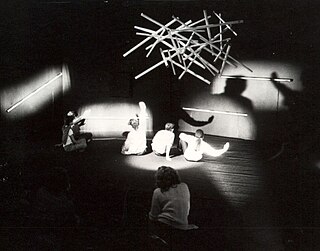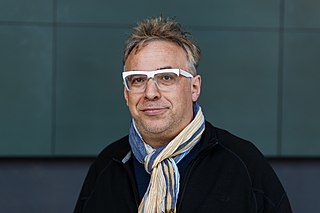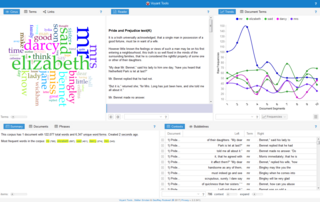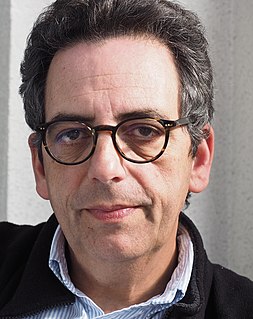
Interactive art is a form of art that involves the spectator in a way that allows the art to achieve its purpose. Some interactive art installations achieve this by letting the observer or visitor "walk" in, on, and around them; some others ask the artist or the spectators to become part of the artwork.
Postdigital, in artistic practice, is an attitude that is more concerned with being human, than with being digital, similar to the concept of "undigital" introduced in 1995, where technology and society advances beyond digital limitations to achieve a totally fluid multimediated reality that is free from artefacts of digital computation.
Information art, which is also known as informatism or data art, is an emerging art form that is inspired by and principally incorporates data, computer science, information technology, artificial intelligence, and related data-driven fields. The information revolution has resulted in over-abundant data that are critical in a wide range of areas, from the Internet to healthcare systems. Related to conceptual art, electronic art and new media art, informatism considers this new technological, economical, and cultural paradigm shift, such that artworks may provide social commentaries, synthesize multiple disciplines, and develop new aesthetics. Realization of information art often take, although not necessarily, interdisciplinary and multidisciplinary approaches incorporating visual, audio, data analysis, performance, and others. Furthermore, physical and virtual installations involving informatism often provide human-computer interaction that generate artistic contents based on the processing of large amounts of data.
Interaction design, often abbreviated as IxD, is "the practice of designing interactive digital products, environments, systems, and services." Beyond the digital aspect, interaction design is also useful when creating physical (non-digital) products, exploring how a user might interact with it. Common topics of interaction design include design, human–computer interaction, and software development. While interaction design has an interest in form, its main area of focus rests on behavior. Rather than analyzing how things are, interaction design synthesizes and imagines things as they could be. This element of interaction design is what characterizes IxD as a design field as opposed to a science or engineering field.

Henry Jenkins III is an American media scholar and Provost Professor of Communication, Journalism, and Cinematic Arts, a joint professorship at the University of Southern California (USC) Annenberg School for Communication and Journalism and the USC School of Cinematic Arts. He also has a joint faculty appointment with the USC Rossier School of Education. Previously, Jenkins was the Peter de Florez Professor of Humanities as well as co-founder and co-director of the Comparative Media Studies program at the Massachusetts Institute of Technology (MIT). He has also served on the technical advisory board at ZeniMax Media, parent company of video game publisher Bethesda Softworks. In 2013, he was appointed to the board that selects the prestigious Peabody Award winners.

Lev Manovich is an author of books on digital culture and new media, and professor of Computer Science at the Graduate Center, City University of New York. Manovich's current research and teaching focuses on digital humanities, social computing, new media art and theory, and software studies.

Digital humanities (DH) is an area of scholarly activity at the intersection of computing or digital technologies and the disciplines of the humanities. It includes the systematic use of digital resources in the humanities, as well as the analysis of their application. DH can be defined as new ways of doing scholarship that involve collaborative, transdisciplinary, and computationally engaged research, teaching, and publishing. It brings digital tools and methods to the study of the humanities with the recognition that the printed word is no longer the main medium for knowledge production and distribution.

BioArt is an art practice where humans work with live tissues, bacteria, living organisms, and life processes. Using scientific processes such as biotechnology the artworks are produced in laboratories, galleries, or artists' studios. The scope of BioArt is considered by some artists to be strictly limited to "living forms", while other artists would include art that uses the imagery of contemporary medicine and biological research, or require that it address a controversy or blind spot posed by the very character of the life sciences.

Virtual art is a term for the virtualization of art, made with the technical media developed at the end of the 1980s. These include human-machine interfaces such as visualization casks, stereoscopic spectacles and screens, digital painting and sculpture, generators of three-dimensional sound, data gloves, data clothes, position sensors, tactile and power feed-back systems, etc. As virtual art covers such a wide array of mediums it is a catch-all term for specific focuses within it. Much contemporary art has become, in Frank Popper's terms, virtualized.

Johanna Drucker is an American author, book artist, visual theorist, and cultural critic. Her scholarly writing documents and critiques visual language: letterforms, typography, visual poetry, art, and lately, digital art aesthetics. She is currently the Martin and Bernard Breslauer Professor in the Department of Information Studies at the Graduate School of Education and Information Studies at UCLA.
Software studies is an emerging interdisciplinary research field, which studies software systems and their social and cultural effects. The implementation and use of software has been studied in recent fields such as cyberculture, Internet studies, new media studies, and digital culture, yet prior to software studies, software was rarely ever addressed as a distinct object of study. To study software as an artifact, software studies draws upon methods and theory from the digital humanities and from computational perspectives on software. Methodologically, software studies usually differs from the approaches of computer science and software engineering, which concern themselves primarily with software in information theory and in practical application; however, these fields all share an emphasis on computer literacy, particularly in the areas of programming and source code. This emphasis on analysing software sources and processes often distinguishes software studies from new media studies, which is usually restricted to discussions of interfaces and observable effects.

Edward A. Shanken is an American art historian, whose work focuses on the entwinement of art, science and technology, with a focus on experimental new media art and visual culture. Shanken is an associate professor of digital art & new media at UC Santa Cruz. His scholarship has appeared in numerous journals and anthologies and has been translated into many languages. Shanken is the author of Art and Electronic Media, among other titles.
Jussi Parikka is a Finnish new media theorist and Professor in Digital Aesthetics and Culture at Aarhus University, Denmark. He is also (visiting) Professor in Technological Culture & Aesthetics at Winchester School of Art as well as Visiting Professor at FAMU at the Academy of Performing Arts in Prague. In Finland, he is Docent of digital culture theory at the University of Turku. Until May 2011 Parikka was the Director of the Cultures of the Digital Economy (CoDE) research institute at Anglia Ruskin University and the founding Co-Director of the Anglia Research Centre for Digital Culture. With Ryan Bishop, he also founded the Archaeologies of Media and Technology research unit.
Roberto Simanowski is a German scholar of literature and media studies and founder of dichtung-digital.

Jennifer Steinkamp is an American installation artist who works with video and new media in order to explore ideas about architectural space, motion, and perception.

Internet art is a form of new media art distributed via the Internet. This form of art circumvents the traditional dominance of the physical gallery and museum system. In many cases, the viewer is drawn into some kind of interaction with the work of art. Artists working in this manner are sometimes referred to as net artists.

New media art includes artworks designed and produced by means of electronic media technologies, comprising virtual art, computer graphics, computer animation, digital art, interactive art, sound art, Internet art, video games, robotics, 3D printing, and cyborg art. The term defines itself by the thereby created artwork, which differentiates itself from that deriving from conventional visual arts. New Media art has origins in the worlds of science, art, and performance. Some common themes found in new media art include databases, political and social activism, Afrofuturism, feminism, and identity, a ubiquitous theme found throughout is the incorporation of new technology into the work. The emphasis on medium is a defining feature of much contemporary art and many art schools and major universities now offer majors in "New Genres" or "New Media" and a growing number of graduate programs have emerged internationally. New media art may involve degrees of interaction between artwork and observer or between the artist and the public, as is the case in performance art. Yet, as several theorists and curators have noted, such forms of interaction, social exchange, participation, and transformation do not distinguish new media art but rather serve as a common ground that has parallels in other strands of contemporary art practice. Such insights emphasize the forms of cultural practice that arise concurrently with emerging technological platforms, and question the focus on technological media per se. New Media art involves complex curation and preservation practices that make collecting, installing, and exhibiting the works harder than most other mediums. Many cultural centers and museums have been established to cater to the advanced needs of new media art.
Critical code studies (CCS) is an emerging academic subfield, related to software studies, digital humanities, cultural studies, computer science, human–computer interface, and the do-it-yourself maker culture. Its primary focus is on the cultural significance of computer code, without excluding or focusing solely upon the code's functional purpose. According to Mark C. Marino, it
is an approach that applies critical hermeneutics to the interpretation of computer code, program architecture, and documentation within a socio-historical context. CCS holds that lines of code are not value-neutral and can be analyzed using the theoretical approaches applied to other semiotic systems in addition to particular interpretive methods developed particularly for the discussions of programs.

Florian Brody is an Austrian/American digital media creator, inventor, writer, public speaker, academic, and global business consultant. He is best known for his contributions to the invention and development of Expanded Books, an early form of E-books, at the Voyager Company, and for his writings and public speaking about digital media innovation and marketing, including TEDx talks in Austria, as well as his 1999 essay "The Medium is the Memory," originally published in MIT Press's The Digital Dialectic: New Essays on New Media, edited by Peter Lunenfeld.

Denise Gonzales Crisp is a graphic designer, writer, and professor of graphic design at North Carolina State University College of Design, where she currently directs the graduate program. She holds a M.F.A. in graphic design from the California Institute of the Arts and a B.F.A. from Art Center College of Design.













